#1 - Smoked Brisket
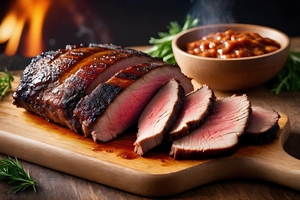
Ashkenazi Jews who settled in Texas during the late 1800s brought with them a culinary tradition shaped by both necessity and religious law. Brisket, a tough and inexpensive cut from the lower chest of beef, was widely used because it was kosher and affordable. Once in Texas, Jewish immigrants found cattle far more plentiful than in Eastern Europe. This abundance lowered the cost of beef, making brisket even more accessible. Texas ranching culture and Jewish culinary tradition intersected in a practical way, leading to a new preparation method with smoking.
Jewish Texans were the first to smoke brisket in the United States. Unlike the Southern-style pork barbecue that dominated other regions, the Jewish approach used beef, often seasoned with salt, pepper, and garlic, and smoked low and slow. This adaptation may have been influenced by Central European preservation techniques but adapted to the smoking wood traditions available in Texas. By the early 1900s, smoked brisket appeared on deli menus across the state, especially in cities with significant Jewish populations like Houston, Dallas, and Austin. These Jewish delis helped define what would eventually become a central dish in Texas barbecue.
Smoked Brisket Recipe
| Servings | Cook Time | Equipment |
|---|---|---|
| 10-12 | 10-14 hours | Smoker (wood or pellet), meat thermometer, large cutting board, foil or butcher paper |
Ingredients
- 1 whole packer brisket (10-14 lbs, with both point and flat)
- 1/4 cup kosher salt
- 1/4 cup coarse ground black pepper
- Optional: 1 tbsp garlic powder (some use it, some don't — not traditional, but adds bite)
Instructions
- Trim the brisket by leaving about 1/4 inch of fat on top. Trim any thick, hard fat that won't render. Square up loose edges and thin flaps so it cooks evenly.
- Mix salt and pepper (and garlic powder, if using). Coat the brisket evenly on all sides. Let it sit at room temp for 30-45 minutes while the smoker heats.
- Heat your smoker to 225-250°F. Use post oak if you want the real Texas profile, but hickory or pecan are fine alternatives.
- Place brisket fat-side up on the grate. Insert a meat thermometer in the thickest part of the flat.
- Smoke uncovered until internal temp hits about 165-170°F. This can take 6-8 hours depending on the brisket.
- When it stalls around 165-170°F, wrap tightly in butcher paper (preferred) or heavy-duty foil. This helps push through the stall without steaming it too much.
- Return to smoker and continue cooking until the thickest part hits 203-205°F and a probe slides in like warm butter.
- Pull from smoker and rest the brisket (still wrapped) in a dry cooler or warm oven (160°F max) for 1 to 2 hours.
- Cut across the grain of the flat into 1/4" slices.When you hit the point, rotate 90° and slice again.
#2 - Banana Split
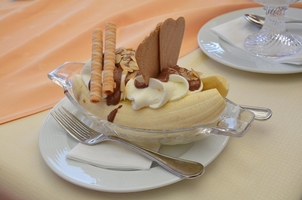
The banana split's exact origin is debated, but most credit David “Doc” Strickler, an optometrist in Latrobe, Pennsylvania, with inventing it in 1904. During a summer trip to Atlantic City, Strickler saw elaborate fruit sundaes and returned home determined to create his own version using bananas, which was then a luxury item shipped into Pennsylvania via New Orleans. His creation sold for 10 cents, double the price of a typical sundae, but quickly gained popularity among students at nearby Saint Vincent College. Word spread fast, both through letters and conversation, and the dessert soon reached far beyond Latrobe.
Classic Banana Split Recipe
| Servings | Cook Time | Equipment |
|---|---|---|
| 1 | 10 minutes | Long ice cream dish or shallow bowl, ice cream scooper |
Ingredients
- 1 ripe banana
- 1 scoop vanilla ice cream
- 1 scoop chocolate ice cream
- 1 scoop strawberry ice cream
- Pineapple topping (crushed pineapple in syrup)
- Chocolate syrup
- Strawberry sauce or preserves
- Whipped cream (real or from a can)
- Maraschino cherries
- Chopped peanuts or walnuts (optional)
Instructions
-
Slice the banana
Peel and cut the banana lengthwise into two even halves. Place both halves in the dish, one on each side, flat side in.
-
Add the ice cream
Arrange three scoops of ice cream between the banana halves: vanilla in the center, chocolate and strawberry on either side.
-
Top each scoop
- Vanilla: spoon over the pineapple topping.
- Chocolate: drizzle with chocolate syrup.
- Strawberry: add a bit of strawberry sauce.
-
Finish it
Add whipped cream on top of each scoop. Garnish with chopped nuts if using, and crown each whipped peak with a maraschino cherry.
#3 - Butter Burger
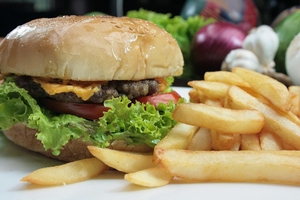
In 1885, Charlie Nagreen fried hamburgers in a pan with butter at the Seymour fair, laying the groundwork for what would later become known as the butter burger. The style gained traction decades later, thanks to Solly's Grille and Kroll's, both of which began serving butter burgers in 1936. Food historian George Motz considers Solly's one of the last true butter burger joints as of 2018, pointing to their method of treating butter like a condiment.
Culver's, founded in 1984, took a different approach by buttering the top bun instead of the meat. Larger chains followed with their own spins: Steak 'n Shake debuted the “Wisconsin Buttery Steakburger” in 2009, combining Wisconsin butter with American cheese, while Jack in the Box rolled out the “Classic Buttery Jack” in 2015, using garlic herb butter melted over the burger patty.
Butter Burger Recipe
| Servings | Cook Time | Equipment |
|---|---|---|
| 4 | 20 minutes | Cast iron skillet or flat-top griddle, spatula |
Ingredients
- 1½ lbs ground chuck (80/20 blend)
- Kosher salt and freshly ground black pepper
- 4 soft hamburger buns (preferably potato or egg buns)
- 8 tbsp unsalted butter, divided
- 1 medium yellow onion, thinly sliced
- Dill pickle slices
- Yellow mustard
Instructions
- Divide the meat into 4 loose portions and shape into patties about 1/2-inch thick. Season with salt and pepper on both sides.
- Melt 2 tablespoons butter in a skillet over medium-low heat. Add sliced onions and cook slowly, stirring occasionally, until golden and soft for about 15-20 minutes. Set aside.
- Heat a cast iron skillet or griddle over medium-high heat. Add the patties and sear for 3-4 minutes per side, flipping once. Press gently for crisp edges but don't smash completely.
- During the final minute of cooking, place 2 tablespoons of butter directly on each patty. Let it melt over the top while the heat's still on.
- While the patties rest briefly, melt a little butter in the pan and toast the buns cut side down until golden.
- Place the burger on the bottom bun. Top with caramelized onions, pickles, or mustard if using, but keep it minimal.
#4 - Tater Tot Hotdish
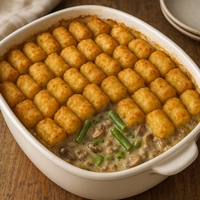
Hotdish became a staple during the Great Depression, when home cooks had to stretch limited ingredients into full meals. Its practicality carried through World War II, when food rationing made one-dish meals even more useful. The concept likely evolved from an earlier American dish sometimes called “hot pot.”
Howard Mohr, in How to Talk Minnesotan, described hotdish as a classic main course served warm from a single baking dish, showing up reliably at church suppers and family gatherings. Ground beef has long been the prefferred meat, paired with canned cream of mushroom soup. While early versions leaned heavily on pasta, newer versions often use tater tots or Minnesota wild rice to bulk it out.
Tater Tot Hotdish Recipe
| Servings | Cook Time | Equipment |
|---|---|---|
| 6-8 | 50-60 minutes | 9x13-inch baking dish, skillet |
Ingredients
- 1 lb ground beef (85/15 or leaner)
- 1 small yellow onion, diced
- 1 can (10.5 oz) condensed cream of mushroom soup
- 1/2 cup whole milk
- 1-2 cups frozen cut green beans (or canned, drained)
- 1 bag (28-32 oz) frozen tater tots
- Kosher salt and ground black pepper
- Optional: shredded cheddar cheese (1 cup)
Instructions
- Preheat oven to 375°F.
-
Brown the beef
In a skillet over medium heat, cook the ground beef and diced onion until browned and fully cooked. Drain excess fat. Season lightly with salt and pepper.
-
Mix the base
In a large bowl, combine the cooked beef mixture with the cream of mushroom soup, milk, and green beans. Stir until well mixed.
-
Assemble
Spread the mixture evenly into the baking dish. Arrange frozen tater tots in a single layer over the top.
-
Bake
Bake uncovered for 40-45 minutes, until the tater tots are golden brown and crisp. If using cheese, sprinkle it on during the last 10 minutes of baking.
-
Cool slightly before serving
Let the dish rest for 5-10 minutes so it sets a bit.
#5 - Golden Apple Pie
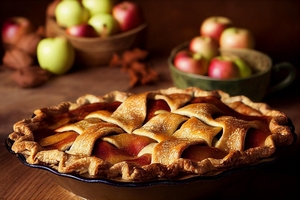
Though often tied to American identity, apple pie has much older origins in Europe. The earliest known recipes appeared in 14th-century England, where apples were baked with figs, raisins, pears, and spices inside a pastry crust. Over the centuries, versions of the dish spread across the continent and eventually crossed the Atlantic with early colonists. In America, apple pie took root as apple orchards became widespread. By the 20th century, the phrase “as American as apple pie” had entered common use, securing the dessert's symbolic status.
“Golden Apple Pie” refers both to the color and to the apples used. A nicely done pie has a golden-brown crust and a warm, amber filling, the result of proper fruit choice and technique. Apples like Golden Delicious, Honeycrisp, and Jonagold are often preferred for their balance of sweetness and color when baked.
Golden Apple Pie Recipe
| Servings | Cook Time | Equipment |
|---|---|---|
| 6-8 | 1 hour | 9-inch pie plate, rolling pin, large mixing bowl |
Ingredients
For the crust:
- 2½ cups all-purpose flour
- 1 tsp kosher salt
- 1 tbsp granulated sugar
- 1 cup (2 sticks) unsalted butter, cold and cut into cubes
- ½ cup ice water (more or less as needed)
For the filling:
- 6 cups thinly sliced apples (Golden Delicious, Honeycrisp, or Jonagold)
- ½ cup light brown sugar
- ¼ cup granulated sugar
- 1½ tbsp lemon juice
- 2 tbsp all-purpose flour
- 1 tsp cinnamon
- ¼ tsp nutmeg
- ⅛ tsp salt
To finish:
- 1 egg, beaten
- 1 tbsp heavy cream or milk (optional, for egg wash)
- Coarse sugar (optional, for crust topping)
Instructions
-
Make the crust
In a large bowl, whisk the flour, salt, and sugar. Cut in the cold butter with a pastry cutter or fingertips until the texture resembles coarse crumbs. Add ice water a tablespoon at a time and mix just until the dough holds together. Divide into two disks, wrap, and chill for at least 1 hour.
-
Prepare the filling
In a large bowl, toss the sliced apples with lemon juice. Add both sugars, flour, cinnamon, nutmeg, and salt. Stir well and let sit 15 minutes while the juices draw out.
-
Assemble the pie
Roll out one dough disk and line the pie plate. Fill with the apple mixture, mounding slightly in the center. Roll out the second disk and lay it over the top. Trim excess dough, crimp the edges, and cut small slits for steam to escape. Chill the whole pie for 20 minutes before baking.
-
Bake
Preheat the oven to 400°F. Brush the top crust with the egg wash (egg beaten with cream or milk). Sprinkle with coarse sugar if using. Bake on the lower rack for 50-60 minutes, until the crust is golden and juices bubble through the slits. If the edges brown too fast, cover with foil.
-
Cool before slicing
Let the pie cool at least 2 hours to allow the filling to set properly.
#6 - Philly Cheesesteak
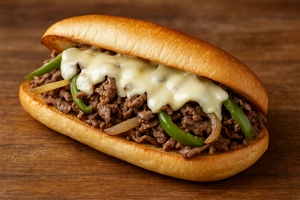
Pat and Harry Olivieri, two brothers from Philadelphia, are widely credited with creating what would become the city's signature sandwich in the early 1930s. The details vary depending on the version, but the core of the story remains the same. They were running a hot dog stand near the Italian Market when they decided to try something different by grilling some chopped beef with onions and tucking it into an Italian roll. As Pat sat down to eat it, a passing cab driver took notice and asked for the same. After finishing it, he told them they were wasting their time with hot dogs and should start selling the steak sandwich instead.
Customers started asking for the new item, and the steak sandwich quickly outpaced their original menu. The brothers leaned into it, and before long, Pat opened his own shop dedicated entirely to the sandwich. That restaurant, Pat's King of Steaks, is still in operation in South Philadelphia, standing as one of the landmarks of the cheesesteak's origin.
Here's a proper classic Philly cheesesteak recipe — stripped to the essentials the way it started: thin-sliced beef, a roll, and onions. Cheese wasn't part of the original, but if you're adding it, keep it traditional.
Philly Cheesesteak Recipe
| Servings | Cook Time | Equipment |
|---|---|---|
| 2 | 10-12 minutes | Flat-top griddle or cast iron skillet, metal spatula |
Ingredients
- 1 lb ribeye steak, thinly sliced
- 1 small yellow onion, diced or thinly sliced
- 2 Italian-style long sandwich rolls
- Kosher salt and black pepper
- Optional: 4 slices provolone, Cheez Whiz, or white American cheese
- Optional: Sliced hot cherry peppers or long hots
Instructions
-
Prep the steak
Slice ribeye very thin. If it's not pre-shaved, freeze the steak for 30-45 minutes to make it easier to cut paper-thin slices and make sure you keep the fat.
-
Cook the onions
Heat a bit of oil on a hot skillet or griddle. Add onions and cook until soft and browned, about 5-7 minutes. Push to the side to keep warm.
-
Cook the steak
Place the beef directly onto the hot surface and season lightly with salt and pepper. Use a spatula to chop and separate the meat as it cooks, flipping and working it into small bits.
-
Add the onions back in
Mix the onions into the meat once it's mostly cooked through. Stir together until evenly combined.
-
Add cheese
Lay slices of provolone or American over the top and let it melt slightly, then stir to incorporate. If using Cheez Whiz, heat it separately and spoon it on at the end.
-
Make the roll
Slice the roll lengthwise but don't cut all the way through. Scoop the hot meat mixture directly into the roll. Spoon on Cheez Whiz now if you skipped the melting step earlier.
#7 - Key Lime Pie
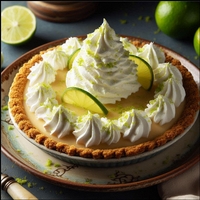
Key lime pie likely evolved from a 1931 promotional recipe called “Magic Lemon Cream Pie,” published by Borden, the condensed milk company. The recipe, credited to Borden's fictional home economist Jane Ellison, called for condensed milk, lemon juice and zest, and egg yolks, topped with meringue and baked before being chilled and served. Pastry chef Stella Parks argues that home cooks adapted this formula using regional ingredients, including key limes in Florida, calling the pie “a stunning reminder of how deeply America's traditions are shaped by advertising.”
In the 1980s, food writer John Egerton traced the presence of key lime pie in the Florida Keys back to the 1890s. Cookbook author Jean Anderson supported this estimate, noting that limited access to fresh milk and refrigeration at the time made canned ingredients like sweetened condensed milk a practical necessity.
Key Lime Pie Recipe
| Servings | Cook Time | Equipment |
|---|---|---|
| 6-8 | 35 minutes | 9-inch pie plate |
Ingredients
For the crust:
- 1½ cups graham cracker crumbs (about 10 full crackers)
- ⅓ cup granulated sugar
- 6 tbsp unsalted butter, melted
- Pinch of salt
For the filling:
- 4 large egg yolks
- 1 can (14 oz) sweetened condensed milk
- ½ cup fresh key lime juice
- 1 tbsp finely grated lime zest
For topping (optional):
- 3 large egg whites
- ¼ tsp cream of tartar
- ¼ cup granulated sugar
Instructions
-
Make the crust
Preheat oven to 350°F. Mix graham cracker crumbs, sugar, salt, and melted butter until evenly combined. Press the mixture firmly into the bottom and sides of a 9-inch pie plate. Bake for 8-10 minutes, just until set. Let it cool while you make the filling.
-
Make the filling
In a bowl, whisk the egg yolks until thickened slightly, about 1 minute. Stir in the condensed milk until smooth, then mix in the lime juice and zest. Pour into the cooled crust.
-
Bake the pie
Bake for 12-15 minutes, just until the center is set but still jiggles slightly. Remove and cool to room temperature, then chill in the refrigerator for at least 4 hours, preferably overnight.
-
Optional meringue topping
Beat egg whites with cream of tartar until soft peaks form. Gradually add sugar and beat until stiff peaks form. Spoon or pipe onto cooled pie and bake at 375°F for 5-7 minutes, or until lightly browned. Cool completely before serving.
#8 - Cobb Salad
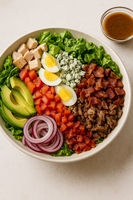
The origins of the Cobb salad are debated, with several versions circulating. One story places its creation in 1937 at the Hollywood Brown Derby, where it became a signature dish. The salad takes its name from the restaurant's owner, Robert Howard Cobb. In some tellings, Cobb himself assembled the salad late one night from kitchen leftovers, adding freshly cooked bacon from the line cook and tossing it all with the house's French dressing.
Another version credits the salad to Robert Kreis, the Brown Derby's executive chef, who is said to have created it in 1929, the same year the Hollywood location opened. According to that story, Kreis named the salad after Cobb. The two stories aren't necessarily in conflict, but 1937 remains the most commonly cited date for Cobb's own involvement, while Kreis's earlier role may have laid the groundwork for the dish's development.
Cobb Salad Recipe
| Servings | Cook Time | Equipment |
|---|---|---|
| 4 | 50 minutes | Big bowl |
Ingredients
For the salad:
- 1 head romaine lettuce, finely chopped
- ½ head iceberg lettuce, finely chopped
- 1 bunch watercress, trimmed and chopped
- 2 medium tomatoes, peeled and diced
- 2 cooked chicken breasts, cold and finely chopped (poached or roasted)
- 6 strips bacon, cooked until crisp and crumbled
- 1 avocado, ripe but firm, peeled and diced
- 3 hard-boiled eggs, finely chopped
- 4 oz Roquefort cheese, crumbled
- Fresh chives, finely chopped (about 2 tbsp)
For the dressing:
- ⅓ cup red wine vinegar
- 1 tbsp fresh lemon juice
- 1 tsp Dijon mustard
- 1 clove garlic, finely minced
- ½ tsp Worcestershire sauce
- ⅔ cup olive oil
- Salt and freshly ground black pepper, to taste
Instructions
-
Make the dressing
In a bowl, whisk together vinegar, lemon juice, mustard, garlic, and Worcestershire. Slowly drizzle in olive oil while whisking until emulsified. Season with salt and pepper to taste. Let it sit for 10 minutes before using.
-
Cook the bacon and eggs
While the dressing rests, cook the bacon until crisp and set aside to drain. Hard-boil the eggs, peel, and chop finely.
-
Prepare the greens
Wash, dry, and finely chop the romaine, iceberg, and watercress. Combine them and spread evenly across a large platter or shallow bowl.
-
Arrange the toppings
Working in neat rows over the bed of greens, arrange the chicken, bacon, eggs, tomatoes, avocado, Roquefort, and chives.
-
Serve
Toss with dressing just before serving, or serve dressing on the side. If tossing, do it gently to keep the distinct ingredients from becoming mush.
#9 - Seafood Boil
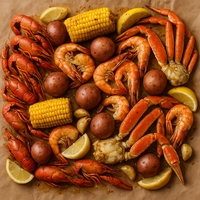
In the United States, a seafood boil is a general term for a social gathering centered around shellfish, either saltwater or freshwater. The specific seafood, cooking method, and side dishes all depend on regional traditions. In some areas, community groups host seafood boils as fundraisers or mixers, much like a fish fry, church supper, or neighborhood barbecue.
Many are smaller, informal events held by families or friends, often during summer weekends or on holidays like Memorial Day and the Fourth of July. Although seafood boils and bakes are most commonly linked to coastal regions, versions of these gatherings appear well inland too, adapted to local ingredients.
Seafood Boil Recipe
| Servings | Cook Time | Equipment |
|---|---|---|
| 6-8 | 1 hour | Large stockpot, slotted spoon or strainer, newspaper or butcher paper for serving |
Ingredients
- 4 quarts water
- 1 12 oz bottle of beer
- ½ cup Old Bay seasoning
- 1 tbsp kosher salt
- 1 tbsp paprika
- 1 lemon, halved
- 1 head garlic, halved crosswise
- 2 lbs small red or yellow potatoes
- 4 ears corn, shucked and cut in halves or thirds
- 1½ lbs smoked sausage, cut into 2-inch pieces
- 2 lbs snow crab legs or Dungeness crab, thawed if frozen
- 2 lbs shell-on shrimp (16/20 count or similar)
- Optional: 1 lb mussels or clams, scrubbed
- ½ cup unsalted butter, melted
- Additional Old Bay for serving
Instructions
-
Build the boil base
Fill the pot with water, add beer if using, and bring to a boil. Stir in Old Bay, salt, paprika, garlic, and lemon. Let it simmer 5 minutes to infuse the broth.
-
Cook in stages
- Add potatoes first and cook for 10-12 minutes.
- Add corn and sausage, cook another 5-6 minutes.
- Add crab legs and mussels (if using), cook for 5 minutes.
- Add shrimp last and cook just until pink, about 2-3 minutes.
-
Drain and serve
Use a slotted spoon or strainer to pull everything out. Spread it across a table lined with paper or serve in large trays. Drizzle with melted butter and sprinkle with more Old Bay to taste.
#10 - Italian Hot Dog
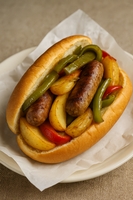
James “Buff” Racioppi, founder of Jimmy Buff's in Newark, New Jersey, introduced the Italian hot dog in 1932. Although the dish became closely tied to his name, it was his wife, Mary Racioppi, who first made it. She prepared the hot dogs for Jimmy and his friends while they played cards. During those games, Jimmy earned the nickname “Buff” because of his confident style at the table, a name that came from Italian and stuck with him.
The sandwich became a hit among friends and family, and its popularity led the Racioppi family to open a restaurant. Jimmy Buff's featured the Italian hot dog from the beginning, and it quickly became the centerpiece of the menu. Customers kept coming back for it, and over time, the sandwich became a defining item for the restaurant.
Today, more than 90 years later, the Italian hot dog remains a favorite at Jimmy Buff's, alongside its counterpart, the Italian sausage. The two continue to compete for the top spot in sales. Although the original location in Newark eventually closed, the Racioppi family and others still serve the dish at newer locations, preserving the tradition and keeping the Italian hot dog alive.
Here's a proper Italian Hot Dog recipe in the style of the original from Jimmy Buff's — deep-fried bread, griddled meats, and a pile of fried potatoes, peppers, and onions. No ketchup, no substitutions, no shortcuts.
Italian Hot Dog Recipe
| Servings | Cook Time | Equipment |
|---|---|---|
| 4 | 45 minutes | Cast iron skillet or deep fryer, flat griddle or pan, slotted spoon |
Ingredients
- 4 all-beef hot dogs
- 4 Italian-style sub rolls or round pizza bread
- 4-5 medium Yukon Gold potatoes, peeled and cut into wedges or thick slices
- 1 large yellow onion, sliced
- 2-3 Italian frying peppers or green bell peppers, sliced
- Canola or peanut oil, for frying
- Kosher salt
Instructions
-
Prep the potatoes
Peel and cut the potatoes into wedges or thick half-moons. Rinse and pat dry thoroughly.
-
Fry the potatoes
In a deep skillet or fryer, heat oil to 350°F. Fry the potato slices in batches until golden and crisp outside, tender inside for about 8-10 minutes per batch. Remove with a slotted spoon and drain on paper towels. Salt immediately.
-
Cook peppers and onions
In a separate skillet, heat a few tablespoons of oil over medium heat. Add onions and peppers. Sauté until softened and browned in spots, about 10-12 minutes. Stir occasionally so they cook evenly without burning.
-
Cook the hot dogs
Grill or griddle the hot dogs until the casing blisters slightly and they are heated through. At Jimmy Buff's, they're fried, but grilling works if you want to avoid the fryer.
-
Toast or fry the bread
If using pizza bread, lightly fry or griddle it cut side down until warm and soft with crisp edges. Sub rolls can be used, but the original sandwich uses thick, chewy pizza bread.
-
Assemble the sandwich
Stuff each roll or pocket with a hot dog, then load it with a generous pile of fried potatoes, sautéed peppers, and onions. Add mustard if you like, but nothing else.